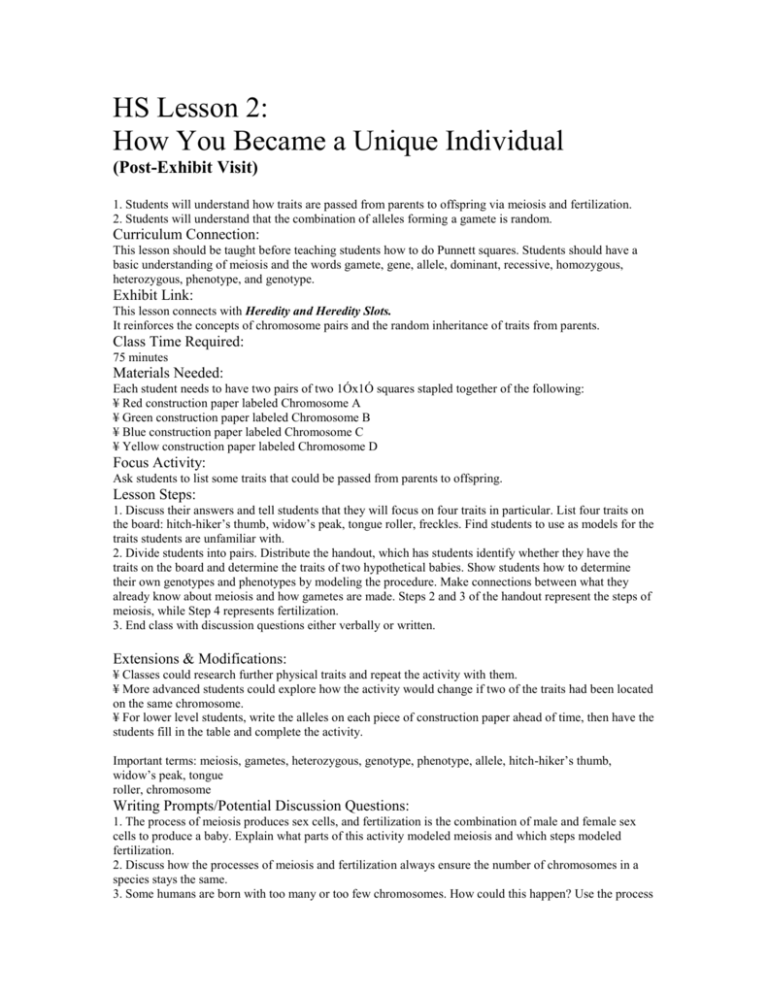doc
advertisement

HS Lesson 2: How You Became a Unique Individual (Post-Exhibit Visit) Objectives: 1. Students will understand how traits are passed from parents to offspring via meiosis and fertilization. 2. Students will understand that the combination of alleles forming a gamete is random. Curriculum Connection: This lesson should be taught before teaching students how to do Punnett squares. Students should have a basic understanding of meiosis and the words gamete, gene, allele, dominant, recessive, homozygous, heterozygous, phenotype, and genotype. Exhibit Link: This lesson connects with Heredity and Heredity Slots. It reinforces the concepts of chromosome pairs and the random inheritance of traits from parents. Class Time Required: 75 minutes Materials Needed: Each student needs to have two pairs of two 1Óx1Ó squares stapled together of the following: ¥ Red construction paper labeled Chromosome A ¥ Green construction paper labeled Chromosome B ¥ Blue construction paper labeled Chromosome C ¥ Yellow construction paper labeled Chromosome D Focus Activity: Ask students to list some traits that could be passed from parents to offspring. Lesson Steps: 1. Discuss their answers and tell students that they will focus on four traits in particular. List four traits on the board: hitch-hiker’s thumb, widow’s peak, tongue roller, freckles. Find students to use as models for the traits students are unfamiliar with. 2. Divide students into pairs. Distribute the handout, which has students identify whether they have the traits on the board and determine the traits of two hypothetical babies. Show students how to determine their own genotypes and phenotypes by modeling the procedure. Make connections between what they already know about meiosis and how gametes are made. Steps 2 and 3 of the handout represent the steps of meiosis, while Step 4 represents fertilization. 3. End class with discussion questions either verbally or written. Extensions & Modifications: ¥ Classes could research further physical traits and repeat the activity with them. ¥ More advanced students could explore how the activity would change if two of the traits had been located on the same chromosome. ¥ For lower level students, write the alleles on each piece of construction paper ahead of time, then have the students fill in the table and complete the activity. Important terms: meiosis, gametes, heterozygous, genotype, phenotype, allele, hitch-hiker’s thumb, widow’s peak, tongue roller, chromosome Writing Prompts/Potential Discussion Questions: 1. The process of meiosis produces sex cells, and fertilization is the combination of male and female sex cells to produce a baby. Explain what parts of this activity modeled meiosis and which steps modeled fertilization. 2. Discuss how the processes of meiosis and fertilization always ensure the number of chromosomes in a species stays the same. 3. Some humans are born with too many or too few chromosomes. How could this happen? Use the process of meiosis in your discussion. 4. Look at the two children you produced in this activity. It is unlikely that they are exactly the same. Human beings inherit thousands of traits from their parents. Using this activity, explain why it is unlikely that any two human beings that are not twins will be identical. Additional Resources: Human Traits Information Page http://www.edquest.ca/Projects/GHTS/traits.html Contains all traits in this activity plus many more with pictures of the traits Hitchhiker’s Thumb http://www.ncrtec.org/tl/camp/gene/thumbs.htm An excellent picture of the difference between hitchhiker’s thumb and a normal thumb National Standards Addressed: Standard C — The Molecular Basis of Heredity Most of the cells in a human contain two copies of each of 22 different chromosomes. In addition, there is a pair of chromosomes that determines sex: a female contains two X chromosomes and a male contains one X and one Y chromosome. Transmission of genetic information to offspring occurs through egg and sperm cells that contain only one representative from each chromosome pair. An egg and a sperm unite to form a new individual. The fact that the human body is formed from cells that contain two copies of each chromosome — and therefore two copies of each gene — explains many features of human heredity, such as how variations that are hidden in one generation can be expressed in the next.









